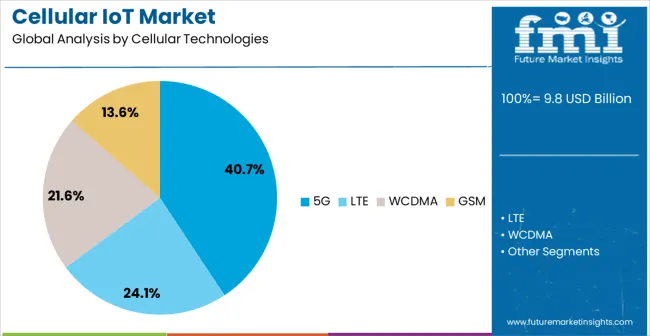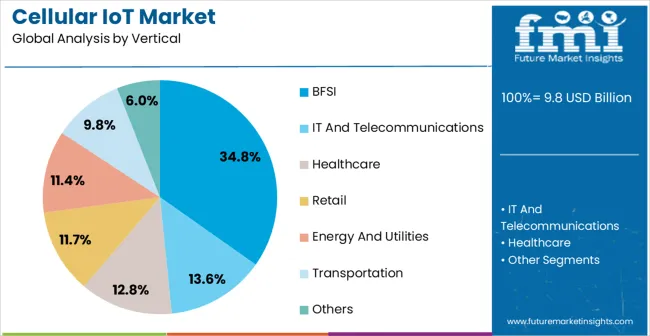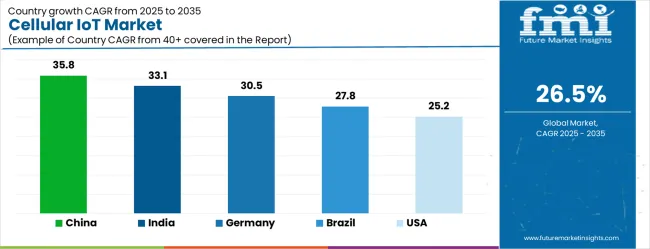The Cellular IoT Market is estimated to be valued at USD 9.8 billion in 2025 and is projected to reach USD 102.7 billion by 2035, registering a compound annual growth rate (CAGR) of 26.5% over the forecast period.
| Metric | Value |
|---|---|
| Cellular IoT Market Estimated Value in (2025 E) | USD 9.8 billion |
| Cellular IoT Market Forecast Value in (2035 F) | USD 102.7 billion |
| Forecast CAGR (2025 to 2035) | 26.5% |
The Cellular IoT market is experiencing robust growth, driven by increasing deployment of connected devices and the expansion of digital infrastructures across various industries. Adoption is being fueled by the rapid rollout of 5G networks, which enable higher data speeds, lower latency, and improved network reliability, supporting real-time monitoring, data collection, and automation across applications. Cellular IoT solutions are being integrated into smart city initiatives, industrial automation, and enterprise digital transformation projects, allowing organizations to optimize operations and enhance service delivery.
The growing need for remote monitoring, predictive maintenance, and enhanced operational efficiency is encouraging adoption across verticals. Security, interoperability, and scalability are increasingly prioritized, further shaping market trends.
Investments in IoT platforms, device management solutions, and network infrastructure are expanding the ecosystem, facilitating broader adoption As organizations continue to seek cost-effective and reliable connectivity for a growing number of IoT devices, the market is expected to experience sustained growth, with cellular technologies serving as a backbone for digital transformation and intelligent automation across industries.
The cellular iot market is segmented by cellular technologies, vertical, and geographic regions. By cellular technologies, cellular iot market is divided into 5G, LTE, WCDMA, and GSM. In terms of vertical, cellular iot market is classified into BFSI, IT And Telecommunications, Healthcare, Retail, Energy And Utilities, Transportation, and Others. Regionally, the cellular iot industry is classified into North America, Latin America, Western Europe, Eastern Europe, Balkan & Baltic Countries, Russia & Belarus, Central Asia, East Asia, South Asia & Pacific, and the Middle East & Africa.

The 5G segment is projected to hold 40.7% of the Cellular IoT market revenue in 2025, establishing it as the leading cellular technology. Growth is being driven by the ability of 5G networks to support massive IoT device connectivity, ultra-low latency, and high-speed data transmission. These capabilities enable advanced applications such as autonomous systems, real-time analytics, and mission-critical communications.
Enhanced network reliability and scalability reduce operational risks while supporting complex industrial and enterprise IoT deployments. The adoption of 5G-enabled IoT devices is also encouraged by improved energy efficiency and lower total cost of ownership compared to legacy networks.
Enterprises are leveraging 5G networks to optimize supply chain operations, enable predictive maintenance, and implement smart city solutions With continued investments in 5G infrastructure and increasing standardization, the 5G segment is expected to maintain its leading position, driven by the demand for faster, more reliable, and scalable connectivity for diverse IoT applications across multiple industries.

The BFSI vertical segment is anticipated to account for 34.8% of the Cellular IoT market revenue in 2025, making it the leading industry vertical. Its growth is driven by the increasing deployment of IoT solutions for real-time asset monitoring, secure transaction processing, and enhanced customer engagement. Financial institutions are leveraging cellular IoT to implement intelligent ATM monitoring, remote branch management, and fraud detection systems.
IoT-enabled devices provide actionable insights for risk management, operational efficiency, and compliance with regulatory requirements. The adoption of 5G connectivity further enhances transaction speed, data security, and device interoperability across banking and insurance operations.
Increasing investment in digital banking, fintech solutions, and mobile payment systems is accelerating demand for IoT-enabled monitoring and analytics capabilities As BFSI organizations prioritize digital transformation, operational resilience, and enhanced customer experience, the segment is expected to sustain its market leadership, supported by continued technological innovation, improved network capabilities, and robust data-driven decision-making frameworks.
In this ever changing technological world, more and more devices are getting contacted together and building internet of things (IoT) architecture across the world. In fact, all the internet devices will be connected in future. IoT is a key facilitator of this possibility by delivering machine-to-machine and machine-to-person communication on a huge scale. FMI predicts that there will more than 30 billion connected devices by year 2025.
Large segment of these devices will be connected through LAN, Wi-Fi, and other short range radio wave technologies while some portion of these devices will be connected through wireless area networks (WAN) that are primarily facilitated by cellular networks.
As in entire IoT landscape, connectivity plays a significant role, that’s why cellular operators are in excellent position to have a slice of big pie by adding value in IoT market. The size of this slice of pie depends on the different role operator’s play in the eco-system of IoT. Different monetization models operator can look for are network providers, end-to-end solution providers, system integrator, etc.

| Country | CAGR |
|---|---|
| China | 35.8% |
| India | 33.1% |
| Germany | 30.5% |
| Brazil | 27.8% |
| USA | 25.2% |
| UK | 22.5% |
| Japan | 19.9% |
The Cellular IoT Market is expected to register a CAGR of 26.5% during the forecast period, exhibiting varied country level momentum. China leads with the highest CAGR of 35.8%, followed by India at 33.1%. Developed markets such as Germany, France, and the UK continue to expand steadily, while the USA is likely to grow at consistent rates. Japan posts the lowest CAGR at 19.9%, yet still underscores a broadly positive trajectory for the global Cellular IoT Market. In 2024, Germany held a dominant revenue in the Western Europe market and is expected to grow with a CAGR of 30.5%. The USA Cellular IoT Market is estimated to be valued at USD 3.5 billion in 2025 and is anticipated to reach a valuation of USD 3.5 billion by 2035. Sales are projected to rise at a CAGR of 0.0% over the forecast period between 2025 and 2035. While Japan and South Korea markets are estimated to be valued at USD 477.3 million and USD 338.9 million respectively in 2025.

| Item | Value |
|---|---|
| Quantitative Units | USD 9.8 Billion |
| Cellular Technologies | 5G, LTE, WCDMA, and GSM |
| Vertical | BFSI, IT And Telecommunications, Healthcare, Retail, Energy And Utilities, Transportation, and Others |
| Regions Covered | North America, Europe, Asia-Pacific, Latin America, Middle East & Africa |
| Country Covered | United States, Canada, Germany, France, United Kingdom, China, Japan, India, Brazil, South Africa |
| Key Companies Profiled | Cisco Systems, Inc., Verizon Communications Inc., Huawei Technologies Co. Ltd., Microsoft Corporation, Telefonaktiebolaget LM Ericsson, AT&T Inc., Tata Communications, Semtech, Quectel Wireless Solutions Co., Ltd, and Fibocom Wireless Inc. |
The global cellular IoT market is estimated to be valued at USD 9.8 billion in 2025.
The market size for the cellular IoT market is projected to reach USD 102.7 billion by 2035.
The cellular IoT market is expected to grow at a 26.5% CAGR between 2025 and 2035.
The key product types in cellular IoT market are 5g, lte, wcdma and gsm.
In terms of vertical, bfsi segment to command 34.8% share in the cellular IoT market in 2025.






Full Research Suite comprises of:
Market outlook & trends analysis
Interviews & case studies
Strategic recommendations
Vendor profiles & capabilities analysis
5-year forecasts
8 regions and 60+ country-level data splits
Market segment data splits
12 months of continuous data updates
DELIVERED AS:
PDF EXCEL ONLINE
Cellular IoT Module Market Size and Share Forecast Outlook 2025 to 2035
Cellular Push-to-talk Market Size and Share Forecast Outlook 2025 to 2035
Cellular Modem Market Size and Share Forecast Outlook 2025 to 2035
Cellular M2M Market Size and Share Forecast Outlook 2025 to 2035
Cellular Renewal Actives Market Analysis - Size and Share Forecast Outlook 2025 to 2035
Cellular Vehicle-To-Everything (C-V2X) Market Size and Share Forecast Outlook 2025 to 2035
Cellular Blinds & Shades Market Size and Share Forecast Outlook 2025 to 2035
Cellular Health Supplement Market Size and Share Forecast Outlook 2025 to 2035
Cellular Rubber Market Growth - Trends & Forecast 2025 to 2035
Cellular Pathology Market Analysis – Size, Share & Forecast 2025 to 2035
Cellular M2M Connections and Services Market - Trends & Forecast 2025 to 2035
Cellular Nutrition Market Analysis by Product Type, End User, Form, Function, Sales Channel and Region from 2025 to 2035
Cellular Reprogramming Tools Market – Demand & Forecast 2025 to 2035
Cellular Epigenetics Market
Microcellular Foam Market Size and Share Forecast Outlook 2025 to 2035
Extracellular Matrix Proteins Market
Hepatocellular Carcinoma HCC Treatment Market Size and Share Forecast Outlook 2025 to 2035
Repeaters for Cellular Network Market Forecast and Outlook 2025 to 2035
Unresectable Hepatocellular Carcinoma Market - Growth & Outlook 2025 to 2035
IoT Spend by Logistics Market Size and Share Forecast Outlook 2025 to 2035

Thank you!
You will receive an email from our Business Development Manager. Please be sure to check your SPAM/JUNK folder too.
Chat With
MaRIA